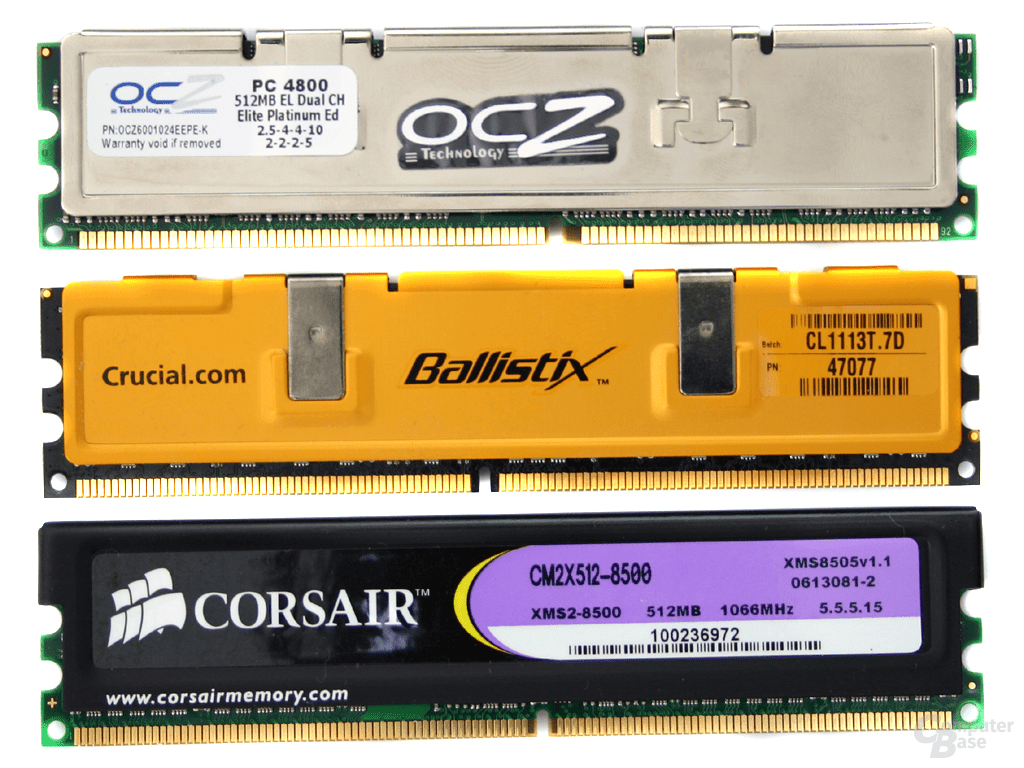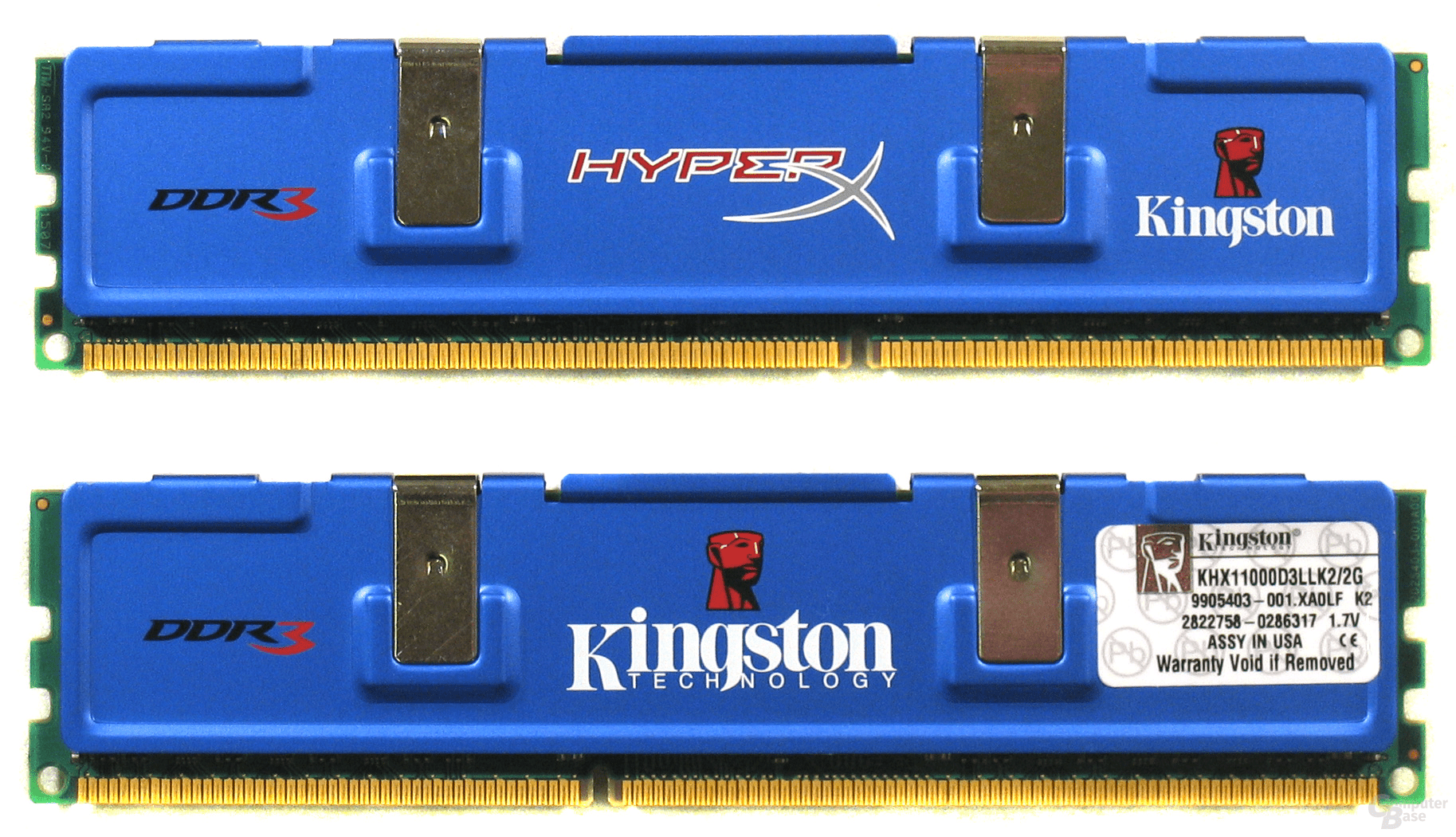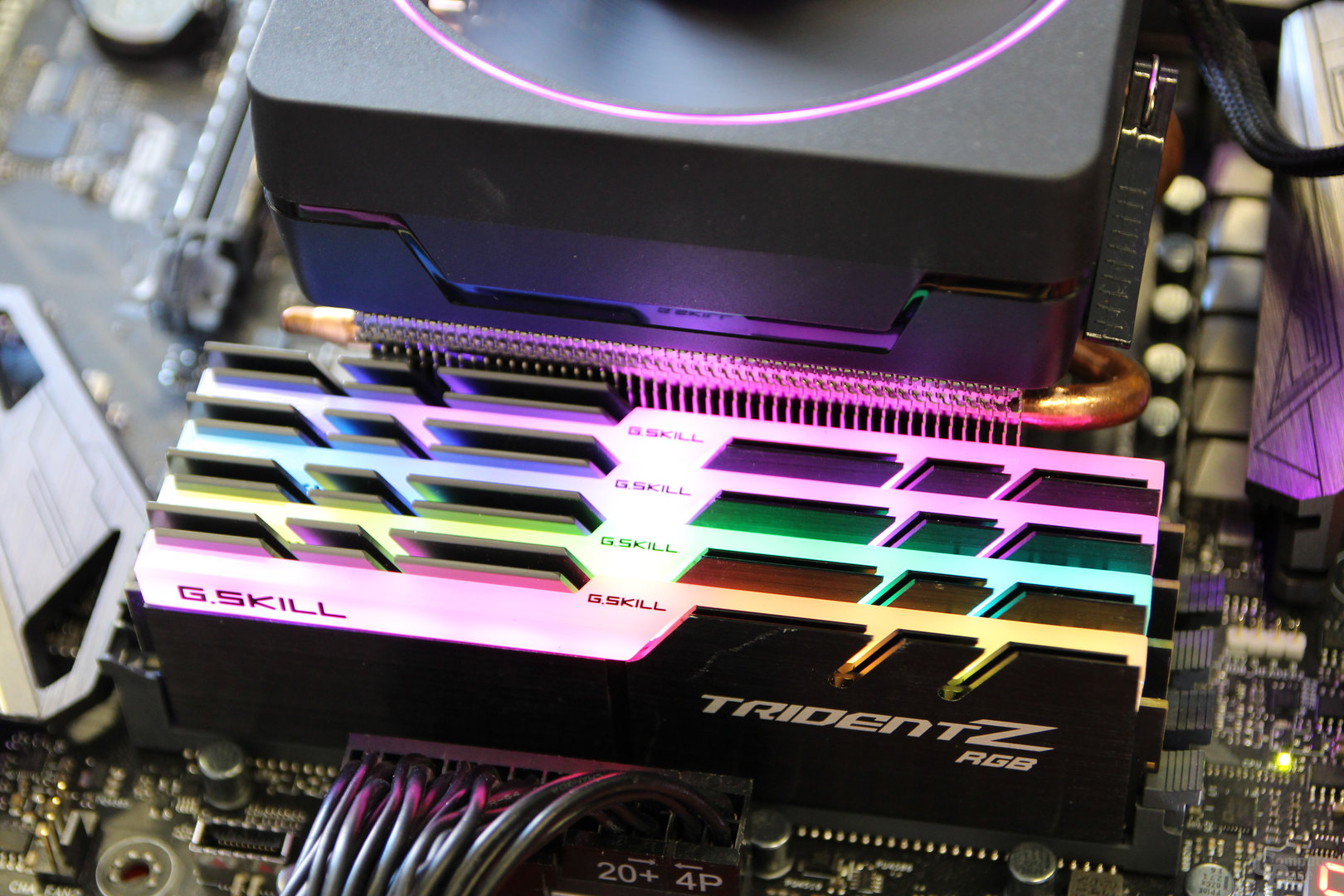Then as now, more than the effective memory clock counts for the classification of the speed of RAM and memory latency is often extremely relevant, especially for gamers. ComputerBase takes a brief look back at DDR, DDR2, DDR3 and DDR4 and forward to DDR5.
Table of contents
- 1 DDR to DDR5: Memory latencies from then to now
- A generation issue
- DDR to DDR5 in a generation comparison
- DDR-SDRAM
- DDR2- SDRAM
- DDR3-SDRAM
- DDR4-SDRAM
- DDR5-SDRAM
- DDR to DDR5 in direct comparison
- DDR4-3200 with CL22 to CL14 in comparison
DDR to DDR5: memory latencies from then to now
Already the “ D ouble D ata R ate S ynchronous D ynamic R andom < strong> A ccess M emory ”or DDR-SDRAM (test), which came on the market at the end of 1999 but did not gain wide acceptance until 2002, was mainly advertised on the basis of its effective memory clock of up to 400 MHz according to the specifications of the JEDEC standard. At that time, memory kits of the type DDR-400 were particularly popular among gamers.
A generation question
In the meantime, with DDR5, the 5th generation of DDR memory is also just around the corner in the consumer area, while the new memory in the enterprise segment has been in test operation since 2020 and with the Intel Sapphire Rapids and later also AMD Genoa platforms Normal operation will be overridden.
JEDEC has officially specified DDR5-3200 to DDR5-8400, but what about the effective memory clock and the I/O clock, the real memory clock and memory bandwidth? The editors provide an overview below.
DDR to DDR5 in a generation comparison
DDR, DDR2, DDR3, DDR4 and DDR5 with a real memory clock of 100 to 525 MHz in comparison of the generations.
DDR-SDRAM
PC- 1600 100 MHz 100 MHz 200 MHz 1.6 GB/s
200 MT/s DDR-266
PC-2100 133 MHz 133 MHz 266 MHz 2.1 GB/s
266 MT/s DDR-333
PC-2700 166 MHz 166 MHz 333 MHz 2.7 GB/s
333 MT/s DDR-400
PC-3200 200 MHz 200 MHz 400 MHz 3.2 GB/s
400 MT/s *) connection to the storage controller; **) Clock compared to SDRAM

The memory latency of a memory module with the DDR-400 CL2, which was typical at the time, was around 10 ns, while a cheap bar with DDR-266 CL2.5 came to around 19 ns. The formula is: 1,000/effective clock in MHz × 2 × CAS latency.
For the little-used DDR-200 with a CAS latency of 3 cycles, this is Formula thus: 1,000/200 × 2 × 3 = 30 ns.
DDR2-SDRAM
PC-3200 100 MHz 200 MHz 400 MHz 3.2 GB/s
400 MT/s DDR2-533
PC-4200 133 MHz 266 MHz 533 MHz 4.2 GB/s
533 MT/s DDR2-667 < br> PC-5300 166 MHz 333 MHz 667 MHz 5.3 GB/s
667 MT/s DDR2-800
PC-6400 200 MHz 400 MHz 800 MHz 6.4 GB/s
800 MT/s DDR2-1066
PC-8500 266 MHz 533 MHz 1,066 MHz 8.5 GB/s
1,066 MT/s *) Connection to the memory controller ; **) Clock compared to SDRAM
 DDR2-SDRAM type RAM
DDR2-SDRAM type RAM 2nd generation DDR memory with DDR2-533 CL4 (test) achieved a latency of around 15 ns, while DDR2-800 CL5, which is often the first choice for gamers, achieved a shorter 12.5 ns. With DDR2-1066, more than 1,000 megatransfers per second (MT/s) of transfer speed with DDR main memory were achieved for the first time.
DDR3-SDRAM
PC-6400 100 MHz 400 MHz 800 MHz 6.4 GB/s
800 MT/s DDR3-1066
PC-8500 133 MHz 533 MHz 1,066 MHz 8.4 GB/s
1,066 MT/s DDR3-1333
PC-10600 166 MHz 667 MHz 1,333 MHz 10.6 GB/s
1,333 MT/s DDR3-1600
PC-12800 200 MHz 800 MHz 1,600 MHz 12.8 GB/s
1,600 MT/s DDR3-2133
PC-17000 266 MHz 1.066 MHz 2.133 MHz 17.0 GB/s
2.133 MT/s *) connection to the memory controller; **) Clock compared to SDRAM
 DDR3-SDRAM by Kingston
DDR3-SDRAM by Kingston DDR3-2133 CL10 not only shone with a memory bandwidth of 17 GB/s and 2,133 MT/s, but also had a latency of just 9.37 ns .
DDR4-SDRAM
PC-12800 200 MHz 800 MHz 1,600 MHz 12.8 GB/s
1,600 MT/s DDR4-1866
PC-14900 233 MHz 933 MHz 1,866 MHz 14.9 GB/s
1,866 MT/s DDR4-2133
PC-17000 266 MHz 1,067 MHz 2,133 MHz 17.0 GB/s
2,133 MT/s DDR4-2400
PC-19200 300 MHz 1,200 MHz 2,400 MHz 19.2 GB/s
2,400 MT/s DDR4-2666
PC-21300 333 MHz 1,333 MHz 2,666 MHz 21.3 GB/s
2,666 MT/s DDR4-3200 < br> PC-25600 400 MHz 1,600 MHz 3,200 MHz 25.6 GB/s
3,200 MT/s DDR4-3600
PC-28800 450 MHz 1,800 MHz 3,600 MHz 28.8 GB/s
3,600 MT/s DDR4-4800
PC-38400 600 MHz 2,400 MHz 4,800 MHz 38.4 GB/s
4,800 MT/s *) Connection to the memory controller ; **) Clock compared to SDRAM
 G.Skill TridentZ RGB with DDR4-3200
G.Skill TridentZ RGB with DDR4-3200 Users who, for example, have DDR4-3600 CL14 want to get the maximum out of Ryzen 5000 (test), get a memory latency of 7.78 ns, especially due to the low CAS latency. DDR4-4800 CL17 positions itself very close to the “magical” limit of seven nanoseconds with 7.08 ns.
DDR5-SDRAM
PC-25600 200 MHz 1,600 MHz 3,200 MHz 25.6 GB/s
3,200 MT/s DDR5-3600
PC-28800 225 MHz 1,800 MHz 3,600 MHz 28.8 GB/s
3,600 MT/s < strong> DDR5-4800
PC-38400 300 MHz 2,400 MHz 4,800 MHz 38.4 GB/s
4,800 MT/s DDR5-5600
PC-44800 350 MHz 2,800 MHz 5,600 MHz 44.8 GB/s
5,600 MT/s DDR5-6400
PC-51200 400 MHz 3,200 MHz 6,400 MHz 51.2 GB/s
6,400 MT/s DDR5-7200
PC-57600 450 MHz 3,600 MHz 7,200 MHz 57.6 GB/s
7,200 MT/s DDR5-8400
PC-67200 600 MHz 4,800 MHz 8,400 MHz 67.2 GB/s
8,400 MT/s *) connection to the memory controller; **) Clock compared to SDRAM
 Teamgroup DDR5 Elite (Image: Teamgroup)
Teamgroup DDR5 Elite (Image: Teamgroup) With Intel's hybrid CPUs of the Alder Lake-S type and later also Zen 4 (“Raphael”) on socket 1718 (“AM5”), DDR5 will also find its way into the consumer sector and at least have to nibble on the high CAS latency at the beginning.
The memory latency of the DDR5-4800 CL40 is initially much higher than that of the fastest DDR3 and DDR4 memory kits.
With the DDR5-8400 CL32, which gamers will later be given the prospect of using Intel XMP 3.0, DDR5 is also back in the 7.6 ns range.
Whether the limit of 7 nanoseconds, as can be achieved with DDR4-4000 CL14, for example, has yet to be shown.
DDR to DDR5 in direct comparison
400 MT/s ~ 10.0 ns DDR2-800 CL5 200 MHz 400 MHz 800 MHz 6.4 GB/s
800 MT/s ~ 12.5 ns DDR3-2133 CL10 266 MHz 1.067 MHz 2.133 MHz 17.0 GB/s
2.133 MT/s ~ 9.4 ns DDR4-4000 CL14 500 MHz 2,000 MHz 4,000 MHz 32.0 GB/s
4,000 MT/s ~ 7.0 ns DDR5-8400 CL40 525 MHz 4,200 MHz 8,400 MHz 67.2 GB/s
8,400 MT/s ~ 9 , 5 ns *) connection to the memory controller; **) Clock compared to SDRAM
Based on a real memory clock of 667 MHz, which the 4th generation has already achieved with DDR4-5333, DDR5-9600 (600 MHz) and DDR5-10400 (650 MHz) can also be expected later for the 5th generation.
In addition to an effectively higher memory rate and the resulting higher memory bandwidth, the capacity per DRAM chip and memory module has also been increased. With 64 Gbit per chip and up to 2 TB per module, DDR5-SDRAM offers four times the capacity of DDR4-SDRAM.
In addition, memory bars of the type DDR5 have a new function called “On-Die ECC” for the first time, but at least “out of the box” it is not a traditional and full-fledged ECC, as Ian Cutress on his YouTube channel “TechTechPotato” “Explained in more detail.
As soon as the first consumer platforms are launched with support for DDR5, the editors will of course examine the new memory in a practical test.
DDR4-3200 with CL22 to CL14 in comparison
Since DDR4-3200 type RAM with a real clock rate of 400 MHz is the highest standard officially supported by the manufacturer in both the current Core i series of the 11th generation Rocket Lake-S (test) and AMD Ryzen 5000 alias Vermeer , the editors have also compared the specifications of this memory type with a rather slow CAS latency of 22 cycles, as provided by JEDEC, with sharp memory latencies and CL18, CL17, CL16, CL15 and CL14.
3,200 MT/s 13,750 ns DDR4-3200 CL18 11,250 ns DDR4 -3200 CL17 10.625 ns DDR4-3200 CL16 10,000 ns DDR4-3200 CL15 9.375 ns DDR4-3200 CL14 8.75 ns
The already commercially available DDR4-3200 CL16 reduces the memory latency in the Compared to the JEDEC standard DDR4-3200 CL22 by around 27.3 percent, DDR4-3200 CL14 has extremely fast 8.75 ns even latencies shorter by around 36.4 percent.
Was this article interesting, helpful, or both? The editors are happy about any support from ComputerBase Pro and deactivated ad blockers. More about advertisements on ComputerBase.

